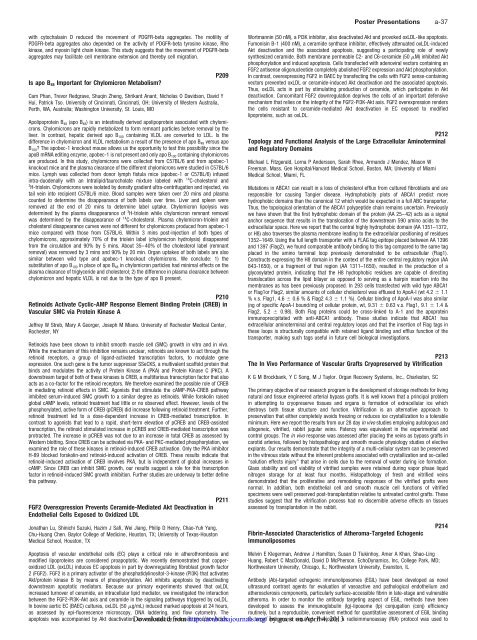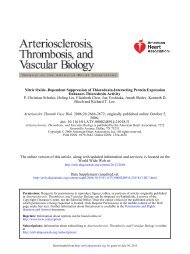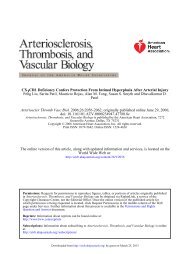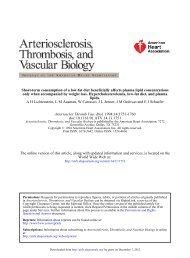Oral Presentations - Arteriosclerosis, Thrombosis, and Vascular ...
Oral Presentations - Arteriosclerosis, Thrombosis, and Vascular ...
Oral Presentations - Arteriosclerosis, Thrombosis, and Vascular ...
You also want an ePaper? Increase the reach of your titles
YUMPU automatically turns print PDFs into web optimized ePapers that Google loves.
with cytochalasin D reduced the movement of PDGFR-beta aggregates. The motility of<br />
PDGFR-beta aggregates also depended on the activity of PDGFR-beta tyrosine kinase, Rho<br />
kinase, <strong>and</strong> myosin light chain kinase. This study suggests that the movement of PDGFR-beta<br />
aggregates may facilitate cell membrane extension <strong>and</strong> thereby cell migration.<br />
Is apo B 48 Important for Chylomicron Metabolism?<br />
Cam Phan, Trevor Redgrave, Shuqin Zheng, Shrikant Anant, Nicholas O Davidson, David Y<br />
Hui, Patrick Tso. University of Cincinnati, Cincinnati, OH; University of Western Australia,<br />
Perth, WA, Australia; Washington University, St. Louis, MO<br />
P209<br />
Apolipoprotein B 48 (apo B 48) is an intestinally derived apolipoprotein associated with chylomicrons.<br />
Chylomicrons are rapidly metabolized to form remnant particles before removal by the<br />
liver. In contrast, hepatic derived apo B 100 containing VLDL are converted to LDL. Is the<br />
difference in chylomicron <strong>and</strong> VLDL metabolism a result of the presence of apo B 48 versus apo<br />
B 100? The apobec-1 knockout mouse allows us the opportunity to test this possibility since the<br />
apoB mRNA editing enzyme, apobec-1 is not present <strong>and</strong> only apo B 100 containing chylomicrons<br />
are produced. In this study, chylomicrons were collected from C57BL/6 <strong>and</strong> from apobec-1<br />
knockout mice <strong>and</strong> the plasma clearance of the different chylomicrons were studied in C57BL/6<br />
mice. Lymph was collected from donor lymph fistula mice (apobec-1 or C57BL/6) infused<br />
intra-duodenally with an Intralipid/taurocholate mixture labeled with 14 C-cholesterol <strong>and</strong><br />
3 H-triolein. Chylomicrons were isolated by density gradient ultra-centrifugation <strong>and</strong> injected, via<br />
tail vein into recipient C57BL/6 mice. Blood samples were taken over 20 mins <strong>and</strong> plasma<br />
counted to determine the disappearance of both labels over time. Liver <strong>and</strong> spleen were<br />
removed at the end of 20 mins to determine label uptake. Chylomicron lipolysis was<br />
determined by the plasma disappearance of 3 H-triolein while chylomicron remnant removal<br />
was determined by the disappearance of 14 C-cholesterol. Plasma chylomicron-triolein <strong>and</strong><br />
cholesterol disappearance curves were not different for chylomicrons produced from apobec-1<br />
mice compared with those from C57BL/6. Within 3 mins post-injection of both types of<br />
chylomicrons, approximately 70% of the triolein label (chylomicron hydrolysis) disappeared<br />
from the circulation <strong>and</strong> 90% by 5 mins. About 35–40% of the cholesterol label (remnant<br />
removal) was removed by 3 mins <strong>and</strong> 90% by 20 min. Organ uptakes of both labels are also<br />
similar between wild type <strong>and</strong> apobec-1 knockout chylomicrons. We conclude: 1) the<br />
substitution of apo B 100 in place of apo B 48 in chylomicron particles had minimal effects on the<br />
plasma clearance of triglyceride <strong>and</strong> cholesterol; 2) the difference in plasma clearance between<br />
chylomicron <strong>and</strong> hepatic VLDL is not due to the type of apo B present.<br />
P210<br />
Retinoids Activate Cyclic-AMP Response Element Binding Protein (CREB) in<br />
<strong>Vascular</strong> SMC via Protein Kinase A<br />
Jeffrey W Streb, Mary A Georger, Joseph M Miano. University of Rochester Medical Center,<br />
Rochester, NY<br />
Retinoids have been shown to inhibit smooth muscle cell (SMC) growth in vitro <strong>and</strong> in vivo.<br />
While the mechanism of this inhibition remains unclear, retinoids are known to act through the<br />
retinoid receptors, a group of lig<strong>and</strong>-activated transcription factors, to modulate gene<br />
expression. One such gene is the tumor suppressor SSeCKS, a multivalent scaffold protein that<br />
binds <strong>and</strong> modulates the activity of Protein Kinase A (PKA) <strong>and</strong> Protein Kinase C (PKC). A<br />
downstream target of both of these kinases is CREB, a multifarious transcription factor that also<br />
acts as a co-factor for the retinoid receptors. We therefore examined the possible role of CREB<br />
in mediating retinoid effects in SMC. Agonists that stimulate the cAMP-PKA-CREB pathway<br />
inhibited serum-induced SMC growth to a similar degree as retinoids. While forskolin raised<br />
global cAMP levels, retinoid treatment had little or no observed effect. However, levels of the<br />
phosphorylated, active form of CREB (pCREB) did increase following retinoid treatment. Further,<br />
retinoid treatment led to a dose-dependent increase in CREB-mediated transcription. In<br />
contrast to agonists that lead to a rapid, short-term elevation of pCREB <strong>and</strong> CREB-assisted<br />
transcription, the retinoid stimulated increase in pCREB <strong>and</strong> CREB-mediated transcription was<br />
protracted. The increase in pCREB was not due to an increase in total CREB as assessed by<br />
Western blotting. Since CREB can be activated via PKA- <strong>and</strong> PKC-mediated phosphorylation, we<br />
examined the role of these kinases in retinoid-induced CREB activation. Only the PKA inhibitor<br />
H-89 blocked forskolin-<strong>and</strong> retinoid-induced activation of CREB. These results indicate that<br />
retinoid-induced activation of CREB involves PKA, but is independent of global increases in<br />
cAMP. Since CREB can inhibit SMC growth, our results suggest a role for this transcription<br />
factor in retinoid-induced SMC growth inhibition. Further studies are underway to better define<br />
this pathway.<br />
FGF2 Overexpression Prevents Ceramide-Mediated Akt Deactivation in<br />
Endothelial Cells Exposed to Oxidized LDL<br />
Jonathan Lu, Shinichi Suzuki, Hazim J Safi, Wei Jiang, Philip D Henry, Chao-Yuh Yang,<br />
Chu-Huang Chen. Baylor College of Medicine, Houston, TX; University of Texas-Houston<br />
Medical School, Houston, TX<br />
P211<br />
Apoptosis of vascular endothelial cells (EC) plays a critical role in atherothrombosis <strong>and</strong><br />
modified lipoproteins are considered proapoptotic. We recently demonstrated that copperoxidized<br />
LDL (oxLDL) induces EC apoptosis in part by downregulating fibroblast growth factor<br />
2 (FGF2). FGF2 is a primary activator of the phosphatidylinositol-3-kinase (PI3K) that activates<br />
Akt/protein kinase B by means of phosphorylation. Akt inhibits apoptosis by deactivating<br />
downstream apoptotic mediators. Because our primary experiments showed that oxLDL<br />
increased turnover of ceramide, an intracellular lipid mediator, we investigated the interaction<br />
between the FGF2-PI3K-Akt axis <strong>and</strong> ceramide in the signaling pathways triggered by oxLDL.<br />
In bovine aortic EC (BAEC) cultures, oxLDL (50 g/mL) induced marked apoptosis at 24 hours,<br />
as assessed by epi-fluorescence microscopy, DNA laddering, <strong>and</strong> flow cytometry. The<br />
apoptosis was accompanied by Akt deactivation, Downloaded as evaluated byfrom reduced phosphorylation.<br />
http://atvb.ahajournals.org/<br />
Poster <strong>Presentations</strong> a-37<br />
Wortmannin (50 nM), a PI3K inhibitor, also deactivated Akt <strong>and</strong> provoked oxLDL-like apoptosis.<br />
Fumonisin B-1 (400 nM), a ceramide synthase inhibitor, effectively attenuated oxLDL-induced<br />
Akt deactivation <strong>and</strong> the associated apoptosis, suggesting a participating role of newly<br />
synthesized ceramide. Both membrane permeable C2- <strong>and</strong> C6-ceramide (50 M) inhibited Akt<br />
phosphorylation <strong>and</strong> induced apoptosis. Cells transfected with adenoviral vectors containing an<br />
FGF2 antisense oligonucleotide completely abolished FGF2 expression <strong>and</strong> Akt phosphorylation.<br />
In contrast, overexpressing FGF2 in BAEC by transfecting the cells with FGF2 sense-containing<br />
vectors prevented oxLDL or ceramide-induced Akt deactivation <strong>and</strong> the associated apoptosis.<br />
Thus, oxLDL acts in part by stimulating production of ceramide, which participates in Akt<br />
deactivation. Concomitant FGF2 downregulation deprives the cells of an important defensive<br />
mechanism that relies on the integrity of the FGF2-PI3K-Akt axis. FGF2 overexpression renders<br />
the cells resistant to ceramide-mediated Akt deactivation in EC exposed to modified<br />
lipoproteins, such as oxLDL.<br />
P212<br />
Topology <strong>and</strong> Functional Analysis of the Large Extracellular Aminoterminal<br />
<strong>and</strong> Regulatory Domains<br />
Michael L Fitzgerald, Lorna P Andersson, Sarah Rhee, Arm<strong>and</strong>o J Mendez, Mason W<br />
Freeman. Mass. Gen Hospital/Harvard Medical School, Boston, MA; University of Miami<br />
Medical School, Miami, FL<br />
Mutations in ABCA1 can result in a loss of cholesterol efflux from cultured fibroblasts <strong>and</strong> are<br />
responsible for causing Tangier disease. Hydrophobicity plots of ABCA1 predict more<br />
hydrophobic domains than the canonical 12 which would be expected in a full ABC transporter.<br />
Thus, the topological orientation of the ABCA1 polypeptide chain remains uncertain. Previously<br />
we have shown that the first hydrophobic domain of the protein (AA 25–42) acts as a signal<br />
anchor sequence that results in the translocation of the downstream 590 amino acids to the<br />
extracellular space. Here we report that the central highly hydrophobic domain (AA 1351–1372,<br />
or H8) also traverses the plasma membrane leading to the extracellular positioning of residues<br />
1352–1649. Using the full length transporter with a FLAG tag epitope placed between AA 1396<br />
<strong>and</strong> 1397 (Flag2), we found comparable antibody binding to this tag compared to the same tag<br />
placed in the amino terminal loop previously demonstrated to be extracellular (Flag1).<br />
Constructs expressing the H8 domain in the context of the entire central regulatory region (AA<br />
843-1650), or a fragment of that region (AA 1311–1650), resulted in the production of a<br />
glycosylated protein, indicating that the H8 hydrophobic residues are capable of directing<br />
translocation across the lipid bilayer as opposed to serving as a hairpin insertion into the<br />
membranes as has been previously proposed. In 293 cells transfected with wild type ABCA1<br />
or Flag1or Flag2, similar amounts of cellular cholesterol was effluxed to ApoA-I (wt 4.2 1.1<br />
% v.s. Flag1, 4.6 0.6 % & Flag2 4.3 1.1 %). Cellular binding of ApoA-I was also similar<br />
(ng of specific ApoA-I bound/mg of cellular protein, wt, 9.31 0.63 v.s. Flag1, 9.1 1.4 &<br />
Flag2, 5.2 0.98). Both Flag proteins could be cross-linked to A-1 <strong>and</strong> the apoprotein<br />
immunoprecipitated with anti-ABCA1 antibody. These studies indicate that ABCA1 has<br />
extracellular aminoterminal <strong>and</strong> central regulatory loops <strong>and</strong> that the insertion of Flag tags in<br />
these loops is structurally compatible with retained lig<strong>and</strong> binding <strong>and</strong> efflux function of the<br />
transporter, making such tags useful in future cell biological investigations.<br />
P213<br />
The In Vivo Performance of <strong>Vascular</strong> Grafts Cryopreserved by Vitrification<br />
K G M Brockbank, Y C Song, M J Taylor. Organ Recovery Systems, Inc., Charleston, SC<br />
The primary objective of our research program is the development of storage methods for living<br />
natural <strong>and</strong> tissue engineered arterial bypass grafts. It is well known that a principal problem<br />
in attempting to cryopreserve tissues <strong>and</strong> organs is formation of extracellular ice which<br />
destroys both tissue structure <strong>and</strong> function. Vitrification is an alternative approach to<br />
preservation that either completely avoids freezing or reduces ice crystallization to a tolerable<br />
minimum. Here we report the results from our 28 day in vivo studies employing autologous <strong>and</strong><br />
allogeneic, vitrified, rabbit jugular veins. Patency was equivalent in the experimental <strong>and</strong><br />
control groups. The in vivo response was assessed after placing the veins as bypass grafts in<br />
carotid arteries, followed by histopathology <strong>and</strong> smooth muscle physiology studies of elective<br />
explants. Our results demonstrate that the integrity of a multi-cellular system can be preserved<br />
in the vitreous state without the inherent problems associated with crystallization <strong>and</strong> so-called<br />
“solution effects injury” that arise in cells due to the removal of water during ice formation.<br />
Glass stability <strong>and</strong> cell viability of vitrified samples were retained during vapor phase liquid<br />
nitrogen storage for at least four months. Histopathology of fresh <strong>and</strong> vitrified veins<br />
demonstrated that the proliferative <strong>and</strong> remodeling responses of the vitrified grafts were<br />
normal. In addition, both endothelial cell <strong>and</strong> smooth muscle cell functions of vitrified<br />
specimens were well preserved post-transplantation relative to untreated control grafts. These<br />
studies suggest that the vitrification process had no discernible adverse effects on tissues<br />
assessed by transplantation in the rabbit.<br />
Fibrin-Associated Characteristics of Atheroma-Targeted Echogenic<br />
Immunoliposomes<br />
Melvin E Klegerman, Andrew J Hamilton, Susan D Tiukinhoy, Amer A Khan, Shao-Ling<br />
Huang, Robert C MacDonald, David D McPherson. EchoDynamics, Inc, College Park, MD;<br />
Northwestern University, Chicago, IL; Northwestern University, Evanston, IL<br />
P214<br />
Antibody (Ab)-targeted echogenic immunoliposomes (EGIL) have been developed as novel<br />
ultrasound contrast agents for evaluation of vasoactive <strong>and</strong> pathological endothelium <strong>and</strong><br />
atherosclerosis components, particularly surface-accessible fibrin in late-stage <strong>and</strong> vulnerable<br />
atheroma. In order to monitor the antibody targeting aspect of EGIL, methods have been<br />
developed to assess the immunoglobulin (Ig)-liposome (lp) conjugation (conj) efficiency<br />
routinely, but a reproducible, convenient method for quantitative assessment of EGIL binding<br />
to target antigens by guest is required. on April Previously, 4, 2013a<br />
radioimmunoassay (RIA) protocol was used to














